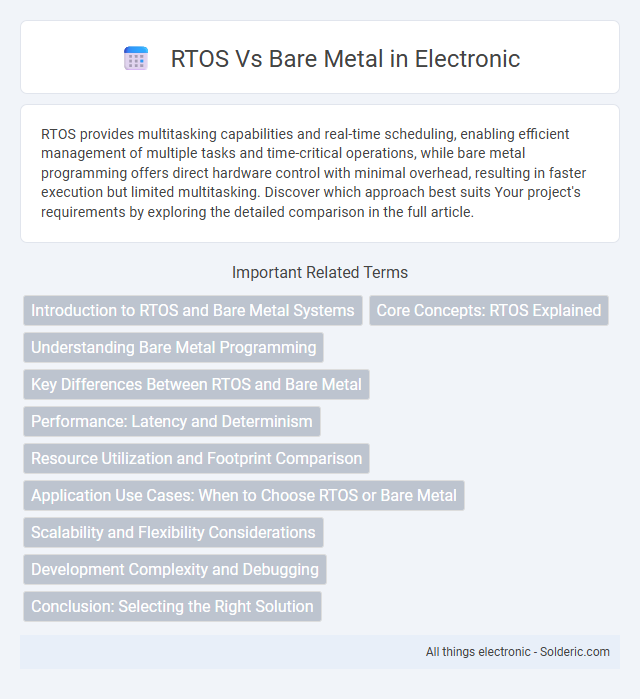RTOS provides multitasking capabilities and real-time scheduling, enabling efficient management of multiple tasks and time-critical operations, while bare metal programming offers direct hardware control with minimal overhead, resulting in faster execution but limited multitasking. Discover which approach best suits Your project's requirements by exploring the detailed comparison in the full article.
Comparison Table
| Feature | RTOS (Real-Time Operating System) | Bare Metal |
|---|---|---|
| Task Management | Supports multitasking with task scheduling and prioritization | No native multitasking; runs a single main loop or function |
| Latency | Low and predictable real-time latency | Minimal latency; fastest response possible |
| Complexity | Higher complexity due to OS overhead | Simpler codebase with direct hardware control |
| Resource Usage | Requires more memory and CPU resources | Very low memory and CPU footprint |
| Development Time | Faster development for complex applications using middleware and services | Longer development time due to manual hardware management |
| Use Cases | Embedded systems requiring multitasking, real-time scheduling, and reliability | Simple, time-critical systems with stringent resource constraints |
| Interrupt Handling | Managed by the OS with priority and latency handling | Direct interrupt handling with minimal overhead |
| Example Platforms | FreeRTOS, VxWorks, ThreadX, Zephyr | Firmware on microcontrollers like STM32, AVR, PIC without OS |
Introduction to RTOS and Bare Metal Systems
RTOS (Real-Time Operating System) provides structured multitasking and real-time scheduling to efficiently manage hardware resources, while bare metal systems run directly on the hardware without an operating system, offering maximum performance and minimal latency. Your choice between RTOS and bare metal depends on application complexity, timing requirements, and resource constraints. RTOS enables easier development of complex, time-critical applications, whereas bare metal programming demands low-level control and optimized resource usage.
Core Concepts: RTOS Explained
An RTOS (Real-Time Operating System) manages hardware resources, executes multiple tasks simultaneously through multitasking, and ensures precise timing and predictable responses critical for real-time applications. Core concepts include task scheduling, inter-task communication, and resource management, which enable efficient handling of concurrent processes. Your choice between RTOS and bare metal depends on the complexity and timing requirements of your embedded system, with RTOS providing structured task management compared to the direct hardware control in bare metal programming.
Understanding Bare Metal Programming
Bare metal programming involves writing software that runs directly on the hardware without an underlying operating system, providing full control over the microcontroller or processor resources. This approach requires detailed knowledge of hardware registers, memory management, and interrupt handling to maximize performance and minimize latency. Unlike RTOS-based systems, bare metal programming lacks built-in multitasking and scheduling features, demanding manual implementation of timing and concurrency mechanisms.
Key Differences Between RTOS and Bare Metal
RTOS provides multitasking capabilities, real-time scheduling, and resource management, enabling your application to handle multiple processes efficiently with predictable timing, unlike bare metal systems that run code sequentially without an operating system. Bare metal programming offers low-level hardware control and minimal latency but requires manual management of timing, interrupts, and concurrency, increasing development complexity. Choosing between RTOS and bare metal depends on your project's requirements for real-time performance, complexity, and resource constraints.
Performance: Latency and Determinism
Bare metal systems offer the lowest latency and highest determinism by running code directly on hardware without an intervening operating system, making them ideal for ultra time-sensitive applications. RTOS introduces minimal overhead while ensuring predictable task scheduling, which provides a balance between responsiveness and system complexity. In performance-critical environments, RTOS enhances multitasking capabilities with deterministic context switching, although it cannot match the absolute latency performance of bare metal implementations.
Resource Utilization and Footprint Comparison
RTOS typically requires more memory and processing power due to its multitasking capabilities, preemptive scheduling, and kernel management, resulting in a larger footprint compared to bare metal applications. Bare metal systems optimize resource utilization by running a single task directly on the hardware, minimizing overhead and enabling tighter control over hardware resources. Resource-constrained environments favor bare metal implementations for minimal footprint, while RTOS suits applications demanding multitasking and real-time responsiveness despite higher resource consumption.
Application Use Cases: When to Choose RTOS or Bare Metal
RTOS suits applications requiring multitasking, real-time responsiveness, and complex event handling, such as automotive systems, industrial automation, and medical devices. Bare metal programming is ideal for simpler, time-critical tasks with minimal overhead, like sensor reading or firmware updating in low-resource microcontrollers. Your choice depends on system complexity, timing requirements, and resource constraints, with RTOS providing scalability and Bare metal offering maximum performance efficiency.
Scalability and Flexibility Considerations
RTOS offers superior scalability and flexibility for complex, multi-tasking embedded systems by efficiently managing multiple threads and resources, adapting to varying workloads and priorities. Bare metal programming provides simplicity and low latency but lacks dynamic task management, making it less flexible for applications requiring frequent updates or expansions. Your choice depends on the need for modular design and system growth versus minimalist, deterministic control.
Development Complexity and Debugging
RTOS development offers structured task management and inter-process communication, reducing complexity compared to bare metal programming, which requires manual handling of hardware resources and scheduling. Debugging in RTOS environments benefits from built-in kernel awareness and real-time tracing tools, whereas bare metal debugging involves low-level hardware registers and interrupts, making fault diagnosis more challenging. Your choice impacts development speed and maintenance, with RTOS easing complexity at the cost of resource overhead, while bare metal provides maximum control but higher debugging difficulty.
Conclusion: Selecting the Right Solution
Choosing between RTOS and bare metal depends on your project's complexity and timing requirements. RTOS offers multitasking capabilities and real-time scheduling ideal for applications needing precise timing and resource management. Bare metal suits simpler, time-critical systems where minimal overhead and maximum control are essential.
RTOS vs Bare metal Infographic

 solderic.com
solderic.com